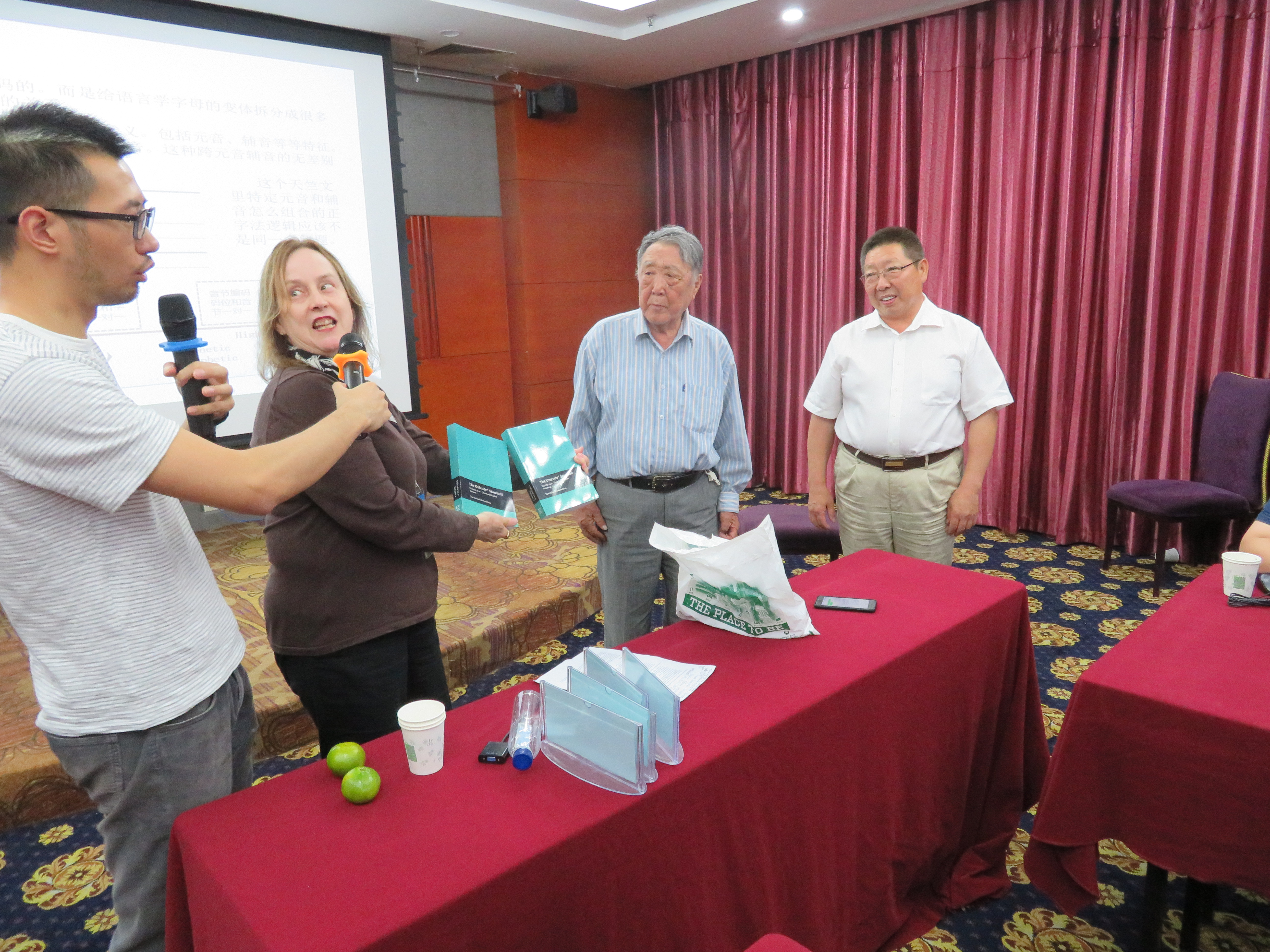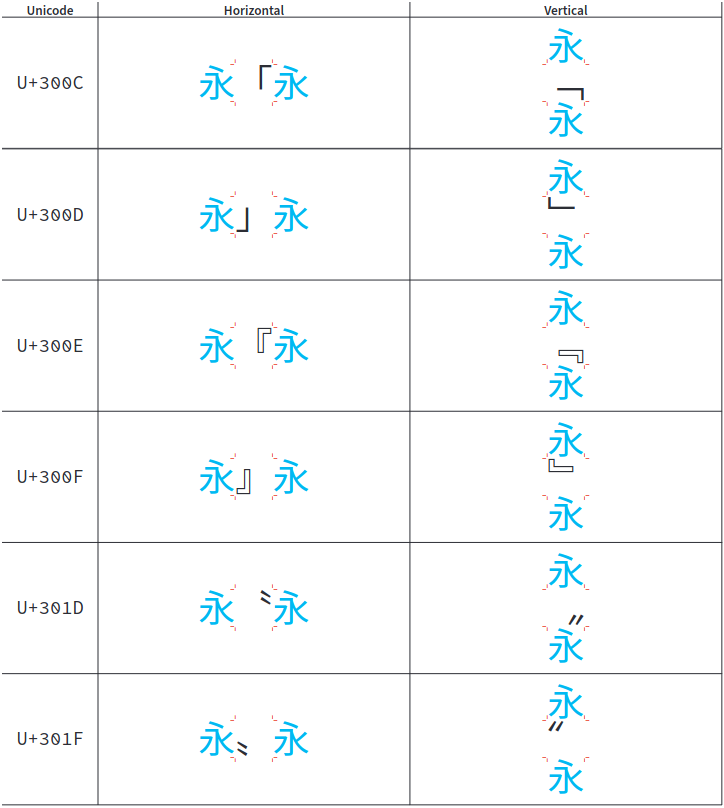|
General Punctuation
General Punctuation is a Unicode block containing punctuation, spacing, and formatting characters for use with all scripts and writing systems. Included are the defined-width spaces, joining formats, directional formats, smart quotes, archaic and novel punctuation such as the interrobang, and invisible mathematical operators. Additional punctuation characters are in the Supplemental Punctuation block and sprinkled in dozens of other Unicode blocks. Block Several characters in this block are usually not rendered with a directly visible glyph. Ten whitespace characters—U+2002 through U+200B (fixed ''en'' or ''1⁄2 em'', ''em'', ''1⁄3 em'', ''1⁄4 em'', ''1⁄6 em'', ''figure'' and ''punctuation space'', variable ''thin'' or ''1⁄5 em'' and ''hair space'', fixed ''zero-width space'')—and U+205F (''math medium'' or ''2⁄9 em space'') differ by horizontal width, while U+2000 and U+2001 (''en'' and ''em quad'') are effectively aliases of U+2002 and U+2003, respectivel ... [...More Info...] [...Related Items...] OR: [Wikipedia] [Google] [Baidu] [Amazon] |
Script (Unicode)
In Unicode, a script is a collection of Letter (alphabet), letters and other written signs used to represent textual information in one or more writing systems. Some scripts support only one writing system and Written language, language, for example, Armenian language, Armenian. Other scripts support many different writing systems; for example, the Latin script in Unicode, Latin script supports English alphabet, English, French alphabet, French, German alphabet, German, Italian alphabet, Italian, Vietnamese language, Vietnamese, Latin alphabet, Latin itself, and several other languages. Some languages make use of multiple alternate writing systems and thus also use several scripts; for example, in Turkish language, Turkish, the Ottoman Turkish alphabet, Arabic script was used before the 20th century but transitioned to Latin in the early part of the 20th century. More or less complementary to scripts are Unicode symbols, symbols and Unicode control characters. The unified Combi ... [...More Info...] [...Related Items...] OR: [Wikipedia] [Google] [Baidu] [Amazon] |
Fullwidth General Quotation Marks
In CJK (Chinese, Japanese, and Korean) computing, graphic characters are traditionally classed into fullwidth and halfwidth characters. Unlike monospaced fonts, a halfwidth character occupies half the width of a fullwidth character, hence the name. ''Halfwidth and Fullwidth Forms'' is also the name of a Unicode block U+FF00–FFEF, provided so that older encodings containing both halfwidth and fullwidth characters can have lossless translation to and from Unicode. Rationale In the days of text mode computing, Western characters were normally laid out in a grid on the screen, often 80 columns by 24 or 25 lines. Each character was displayed as a small dot matrix, often about 8 pixels wide, and an SBCS (single-byte character set) was generally used to encode characters of Western languages. For aesthetic reasons and readability, it is preferable for Chinese characters to be approximately square-shaped, therefore twice as wide as these fixed-width SBCS characters. As these w ... [...More Info...] [...Related Items...] OR: [Wikipedia] [Google] [Baidu] [Amazon] |
Miscellaneous Symbols And Pictographs
Miscellaneous Symbols and Pictographs is a Unicode block containing meteorological and astronomical symbols, emoji characters largely for compatibility with Japanese telephone carriers' implementations of Shift JIS, and characters originally from the Wingdings and Webdings fonts found in Microsoft Windows. Emoji The block contains 637 emoji and has 312 standardized variants defined to specify emoji-style (U+FE0F VS16) or text presentation (U+FE0E VS15) for 156 base characters. Emoji modifiers The Miscellaneous Symbols and Pictographs contains a set of "Emoji modifiers" which are modifier characters intended to represent skin colour based on the Fitzpatrick scale (but conflating the two lightest skin types into one category): : : : : : These emoji modifiers can be used on emojis that represent people or body parts including the 54 human emojis in the Miscellaneous Symbols and Pictograph block. In August 2014, Peter Edberg of Apple Inc. and Mark Davis of Google p ... [...More Info...] [...Related Items...] OR: [Wikipedia] [Google] [Baidu] [Amazon] |
ISO/IEC JTC 1/SC 2
ISO/IEC JTC 1/SC 2 Coded character sets is a standardization subcommittee of the Joint Technical Committee ISO/IEC JTC 1 of the International Organization for Standardization (ISO) and the International Electrotechnical Commission (IEC), that develops and facilitates standards within the field of coded character sets. The international secretariat of ISO/IEC JTC 1/SC 2 is the Japanese Industrial Standards Committee (JISC), located in Japan. SC 2 is responsible for the development of the Universal Coded Character Set standard (ISO/IEC 10646), which is the international standard corresponding to the Unicode Standard. History The subcommittee was established in 1987 under ISO/TC 97 as ISO/TC 97/SC 2, originally with the title "Character Sets and Information Coding", with the area of work being, "the standardization of bit and byte coded representation of information for interchange including among others, sets of graphic characters, of control functions, of picture elements and audi ... [...More Info...] [...Related Items...] OR: [Wikipedia] [Google] [Baidu] [Amazon] |
International Committee For Information Technology Standards
The InterNational Committee for Information Technology Standards (INCITS), (pronounced "insights"), is an ANSI-accredited standards development organization composed of Information technology developers. It was formerly known as the X3 and NCITS. INCITS is the central U.S. forum dedicated to creating technology standards. INCITS is accredited by the American National Standards Institute (ANSI) and is affiliated with the Information Technology Industry Council, a global policy advocacy organization that represents U.S. and global innovation companies. INCITS coordinates technical standards activity between ANSI in the US and joint ISO The International Organization for Standardization (ISO ; ; ) is an independent, non-governmental, international standard development organization composed of representatives from the national standards organizations of member countries. Me .../ IEC committees worldwide. This provides a mechanism to create standards that will be implemen ... [...More Info...] [...Related Items...] OR: [Wikipedia] [Google] [Baidu] [Amazon] |
Unicode Consortium
The Unicode Consortium (legally Unicode, Inc.) is a 501(c)(3) non-profit organization incorporated and based in Mountain View, California, U.S. Its primary purpose is to maintain and publish the Unicode Standard which was developed with the intention of replacing existing character encoding schemes that are limited in size and scope, and are incompatible with multilingual environments. Unicode's success at unifying character sets has led to its widespread adoption in the internationalization and localization of software. The standard has been implemented in many technologies, including XML, the Java programming language, Swift, and modern operating systems. Members are usually but not limited to computer software and hardware companies with an interest in text-processing standards, including Adobe, Apple, the Bangladesh Computer Council, Emojipedia, Facebook, Google, IBM, Microsoft, the Omani Ministry of Endowments and Religious Affairs, Monotype Imaging, Netflix, Sales ... [...More Info...] [...Related Items...] OR: [Wikipedia] [Google] [Baidu] [Amazon] |
Unicode
Unicode or ''The Unicode Standard'' or TUS is a character encoding standard maintained by the Unicode Consortium designed to support the use of text in all of the world's writing systems that can be digitized. Version 16.0 defines 154,998 Character (computing), characters and 168 script (Unicode), scripts used in various ordinary, literary, academic, and technical contexts. Unicode has largely supplanted the previous environment of a myriad of incompatible character sets used within different locales and on different computer architectures. The entire repertoire of these sets, plus many additional characters, were merged into the single Unicode set. Unicode is used to encode the vast majority of text on the Internet, including most web pages, and relevant Unicode support has become a common consideration in contemporary software development. Unicode is ultimately capable of encoding more than 1.1 million characters. The Unicode character repertoire is synchronized with Univers ... [...More Info...] [...Related Items...] OR: [Wikipedia] [Google] [Baidu] [Amazon] |
Emoji
An emoji ( ; plural emoji or emojis; , ) is a pictogram, logogram, ideogram, or smiley embedded in text and used in electronic messages and web pages. The primary function of modern emoji is to fill in emotional cues otherwise missing from typed conversation as well as to replace words as part of a logographic system. Emoji exist in various genres, including facial expressions, expressions, activity, food and drinks, celebrations, flags, objects, symbols, places, types of weather, animals, and nature. Originally meaning pictograph, the word ''emoji'' comes from Japanese + ; the resemblance to the English words ''emotion'' and ''emoticon'' is False cognate, purely coincidental. The first emoji sets were created by Japanese portable electronic device companies in the late 1980s and the 1990s. Emoji became increasingly popular worldwide in the 2010s after Unicode began encoding emoji into the Unicode Standard. They are now considered to be a large part of popular culture ... [...More Info...] [...Related Items...] OR: [Wikipedia] [Google] [Baidu] [Amazon] |
CJK Symbols And Punctuation
CJK Symbols and Punctuation is a Unicode block containing symbols and punctuation used for writing the Chinese, Japanese and Korean languages. It also contains one Chinese character. Block The block has variation sequences defined for East Asian punctuation positional variants. They use (VS01) and (VS02): Orientation Quotation marks and other punctuation have expected differences in behaviour in vertical and horizontal text. The quotation marks 「...」, 『...』 and 〝...〟 rotate 90 degrees, as follows: See also General Punctuation, for variation selectors and CJK behaviour of the Latin quotation marks ‘...’ and “...”. Chinese character The CJK Symbols and Punctuation block contains one Chinese character: . Although it is not covered under "Unified Ideographs", it is treated as a CJK character for all other intents and purposes. Emoji The CJK Symbols and Punctuation block contains two emoji: U+3030 and U+303D. The block has four standardized var ... [...More Info...] [...Related Items...] OR: [Wikipedia] [Google] [Baidu] [Amazon] |
Variant Form (Unicode)
A variant form is an alternate glyph for a character, encoded in Unicode through the mechanism of variation sequences: sequences in Unicode that consist of a base character followed by a variation selector character. A variant form usually has a very similar appearance and meaning as its base form. The mechanism is intended for variant forms where, generally, if the variant form is unavailable, displaying the base character does not change the meaning of the text, and may not even be noticeable to many readers. Unicode defines two types of variation sequences: * ''Standardized variation sequences'' defined in StandardizedVariants.txt * ''Ideographic variation sequences'' defined in the Ideographic Variation Database (IVD) Variation selector characters reside in several Unicode blocks: * Variation Selectors (16 characters abbreviated VS1–VS16) * Variation Selectors Supplement (240 characters abbreviated VS17–VS256) * Mongolian (4 characters abbreviated FVS1–FVS4) Variation ... [...More Info...] [...Related Items...] OR: [Wikipedia] [Google] [Baidu] [Amazon] |
Unicode Block
A Unicode block is one of several contiguous ranges of numeric character codes (code points) of the Unicode character set that are defined by the Unicode Consortium for administrative and documentation purposes. Typically, proposals such as the addition of new glyphs are discussed and evaluated by considering the relevant block or blocks as a whole. Each block is generally, but not always, meant to supply glyphs used by one or more specific languages, or in some general application area such as mathematics, surveying, decorative typesetting, social forums, etc. Design and implementation Unicode blocks are identified by unique names, which use only ASCII characters and are usually descriptive of the nature of the symbols, in English; such as "Tibetan" or "Supplemental Arrows-A". (When comparing block names, one is supposed to equate uppercase with lowercase letters, and ignore any whitespace, hyphens, and underbars; so the last name is equivalent to "supplemental_arrows_a", ... [...More Info...] [...Related Items...] OR: [Wikipedia] [Google] [Baidu] [Amazon] |



